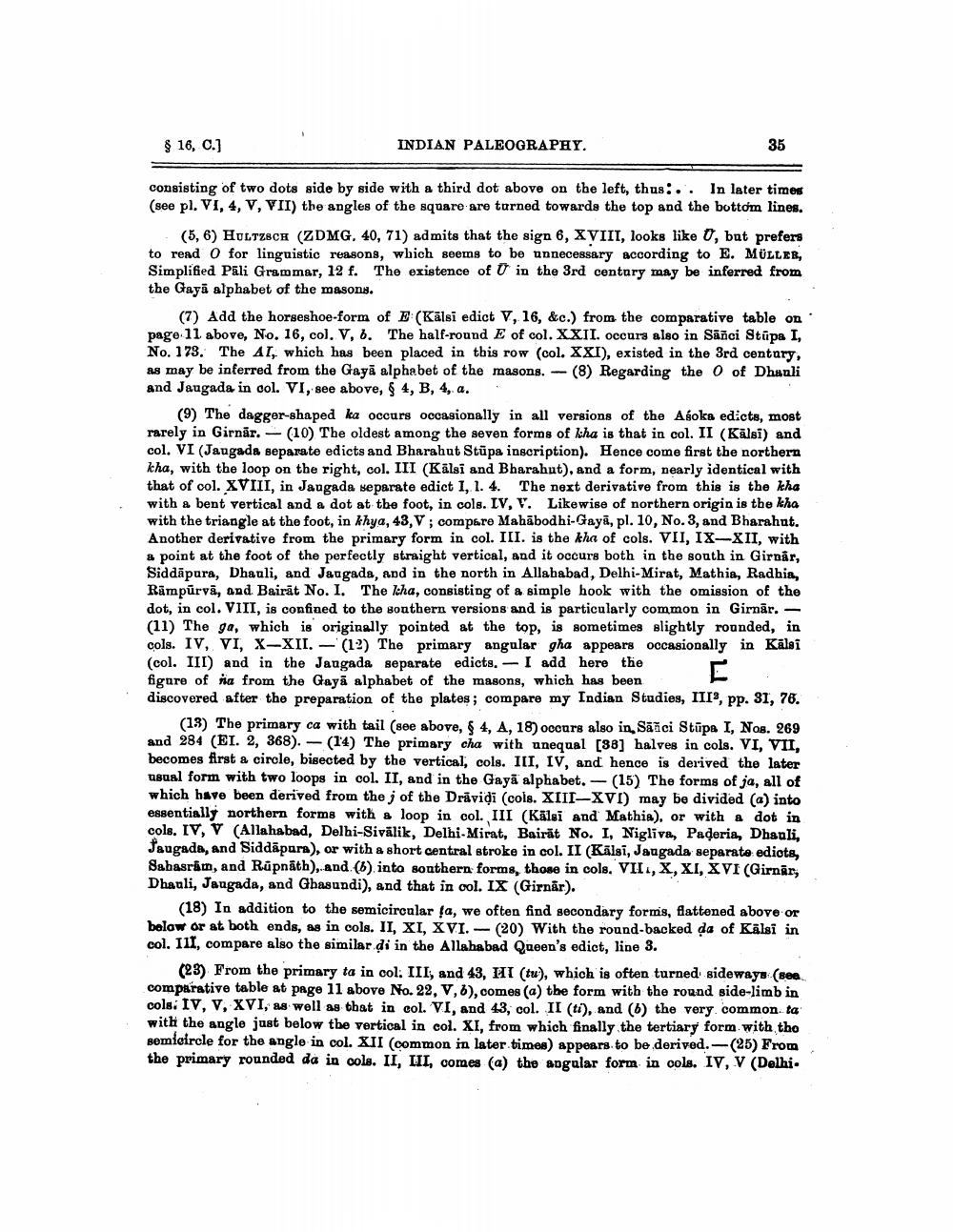________________
$ 16, C.]
INDIAN PALEOGRAPHY.
35
consisting of two dots side by side with a third dot above on the left, thus: .. In later times (see pl. VI, 4, V, VII) the angles of the square are tarned towards the top and the bottom lines.
(5,6) HULTZACH (ZDMG, 40, 71) admits that the sign 6, XVIII, looks like 0, but prefers to read O for linguistic reasons, which seems to be unnecessary according to E. MÜLLER, Simplified Páli Grammar, 12 f. The existence of U in the 3rd centary may be inferred from the Gayā alphabet of the masons.
(7) Add the horseshoe-form of E (Kālsi edict V, 16, &c.) from the comparative table on page 11 above, No. 16, col. V, 6. The half-round E of col. XXII. occurs also in Sānci Stūpa I, No. 173. The AI, which has been placed in this row (col. XXI), existed in the 3rd centary, as may be inferred from the Gayā alphabet of the masons. (8) Regarding the 0 of Dhanli and Jaugada in col. VI, see above, § 4, B, 4, a. "
(9) The dagger-shaped ka occurs occasionally in all versions of the Asoka edicts, most rarely in Girnar. - (10) The oldest among the seven forms of liha is that in col. II (Kälsi) and col. VI (Jangada separate edicts and Bharahut Stüpa inscription). Hence come first the northern kha, with the loop on the right, col. III (Kälsi and Bharahut), and a form, nearly identical with that of col. XVIII, in Jaugada separate edict 1, 1. 4. The next derivative from this is the kha with a bent vertical and a dot at the foot, in cols. IV, V. Likewise of northern origin is the kha with the triangle at the foot, in khya, 43,V; compare Mahābodhi-Gayā, pl. 10, No.3, and Bharahat. Another derivative from the primary form in col. III. is the kha of cols. VII, IX-XII, with & point at the foot of the perfectly straight vertical, and it occurs both in the south in Girnår, Siddāpura, Dhauli, and Jangada, and in the north in Allahabad, Delhi-Mirat, Mathia, Radhia, Rāmpūrvā, and Bairāt No. I. The cha, consisting of a simple hook with the omission of the dot, in col. VIII, is confined to the southern versions and is particularly common in Gimār. - (11) The ga, which is originally pointed at the top, is sometimes slightly rounded, in cols. IV, VI, X-XII. - (12) The primary angular gha appears occasionally in Kalsi (col. III) and in the Jangada separate edicts. - I add here the figure of na from the Gayā alphabet of the masons, which has been discovered after the preparation of the plates; compare my Indian Studies, III, pp. 31, 76.
(13) The primary ca with tail (see above, $ 4, A, 18) occurs also in, Sāici Stūpa I, Nos. 269 and 284 (EI. 2, 368). - (14) The primary cha with unequal [38] halves in cols. VI, VII, becomes first a circle, bisected by the vertical, cols. III, IV, and hence is derived the later ngual form with two loops in col. II, and in the Gayā alphabet. - (15) The forms of ja, all of which have been derived from the j of the Dravidi (cols. XIII-XVI) may be divided (a) into essentially northern forms with a loop in col. III (Kälsi and Mathia), or with a dot in cols. IV, V (Allahabad, Delhi-Sivālik, Delhi-Mirat, Bairāt No. I, Nigliva, Paderia, Dhauli, Jaugada, and Siddāpara), or with a short central stroke in col. II (Kalsī, Jaagada separate ediots, Sabasrâm, and Rūpnāth), and (6), into southern forms, those in cols. VII., X, XI, XVI (Girnar, Dhauli, Jaugada, and Ghasundi), and that in col. IX (Girnar).
(18) In addition to the semicircular ta, we often find secondary forms, flattened above or below or at both ends, as in cols. II, XI, XVI. - (20) With the round-backed da of Kälsi in col. III, compare also the similar di in the Allahabad Queen's edict, line 3.
(23) From the primary ta in col. III, and 43, HI (tu), which is often turned sideways (see comparative table at page 11 above No. 22, V,6), comes (a) the form with the round side-limb in cols: IV, V, XVI, as well as that in col. VI, and 43, col. II (ti), and (6) the very common ta with the angle just below the vertical in col. XI, from which finally the tertiary form with tho semicircle for the angle in col. XII (common in later times) appears to be derived.-(25) From the primary rounded da in cols. II, III, comes (a) the angular form in cols. IV, V (Delhi.




